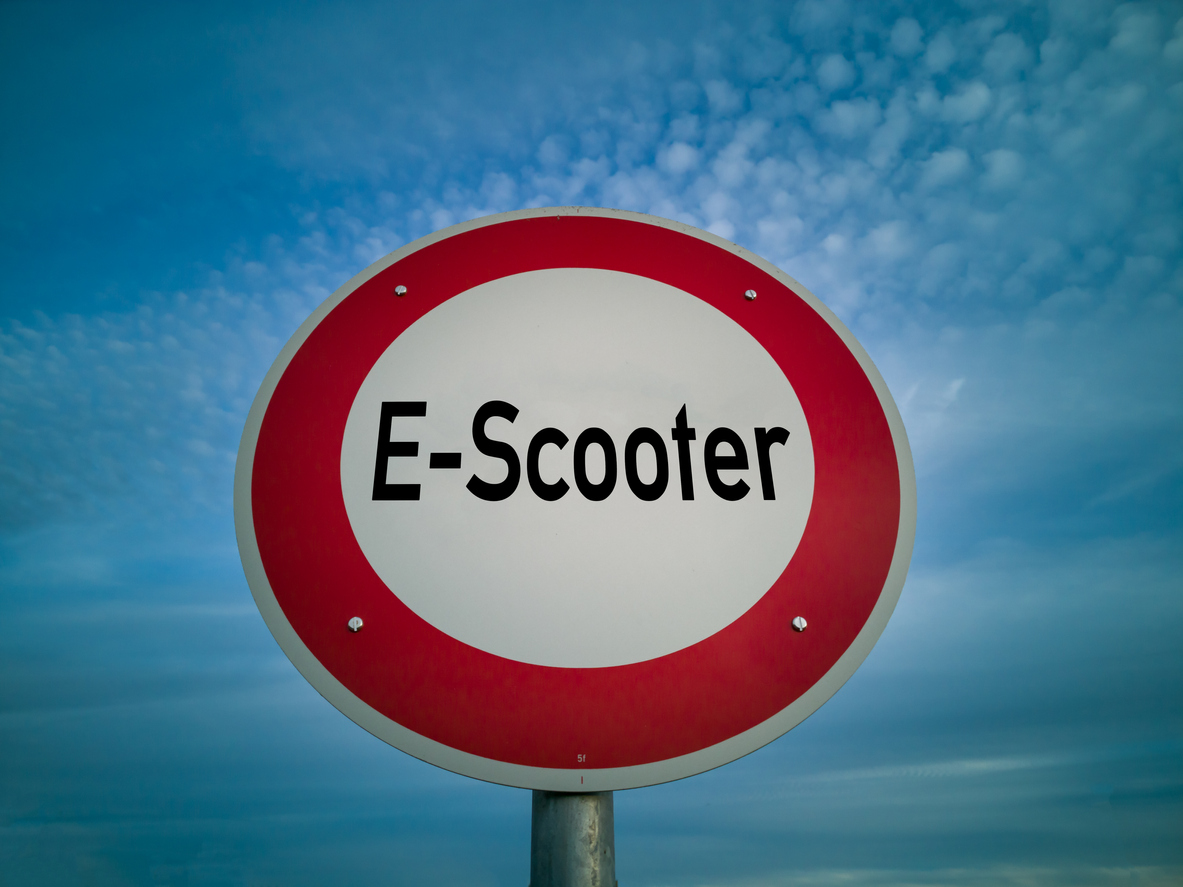Electric Scooters (“E-Scooters”) are electric motor powered “stand-up” scooters often reaching speeds exceeding 15 or 20 mph and usually do not require a driver’s license to operate.1 They are classified as a form of micro-mobility2 and are designed with two wheels and a base deck in the center on which the rider stands.
Since approximately 2017-2018, E-Scooters have been rapidly popping up everywhere across the country. With this relative new form of popular personal transportation, has come new questions regarding traffic-safety, risk, liability, and insurance coverage, to name a few.
A. The Answer to the First Question—Are You Covered Under Your Homeowner or Automobile Insurance Policy?—is “NO”
Homeowner’s Policy: If you are injured or if someone else is injured while you are using an E-Scooter, you will not be covered by a standard homeowner’s insurance policy or renter’s policy. Typically, these policies exclude liabilities caused by a “motorized vehicle” which, by definition, would include an E-Scooter. Therefore, if an E-Scooter hits a pedestrian, the user can be held responsible for the pedestrian’s medical bills, lost wages, and pain and suffering.
Also. a standard automobile insurance policy typically excludes liability coverage for a vehicle with fewer than four wheels—E-Scooters have two—and motorcycle insurance policies usually do not cover scooters that require “users” to stand.
Umbrella Policy: If you are eligible to obtain an umbrella policy (by already having a homeowner’s or automobile insurance policy), such policies generally do have a “recreational vehicles” category under which an E-Scooter might fit and be covered.
B. The Answer to the Second Question—Are E-Scooters Regulated by the State of Texas?—is also a “NO”
E-Scooter Laws: There are no federal E-Scooter statutes or regulations. Likewise, many state governments have no laws, regulations or rules that directly address E-Scooters. Texas is one of those states that does not. Existing Texas transportation laws only speak to motor vehicles, motorcycles, mopeds and bicycles. That situation, however, almost changed in the last 2019 Texas legislative session which ended May 27, 2019. Senate Bill No. 549, “relating to the operation of motor-assisted scooters” was introduced and was passed in the Senate, 20 to 11, but it never reached a vote in the House.
Senate Bill 549 required the E-Scooter operator to be 16-years-old and hold a valid driver’s license. It prohibited more than one person on the scooter at a time and it could be operated only on a path set aside for the exclusive use of bicycles, pedestrians, or both but not on sidewalks. This last provision became a hotly contested issue during debate. The bill also allowed operation on a roadway in a bicycle lane, or if operated on a roadway without a bicycle lane, it could be operated only if the speed limit was 30 mph or less on that roadway.3 The last section of the bill would have allowed counties and cities to add further restrictions and provisions, like increasing the age limit or requiring helmets.4
Starting off the floor debate of Senate Bill 549, Senator Juan Hinojosa, D-McAllen, commented; “It’s like the wild, wild west out there with no rules.”5 Senator Bryan Hughes, R-Mineola, argued against the prohibition from riding E-Scooters on sidewalks, pointing out that there are some situations where it’s safer for a rider to be on the sidewalk than on the street. But Houston R-Senator, Joan Huffman, announced that she had nearly been hit three times by a scooter on a sidewalk and that the sidewalk ban was key for safety. “What about my personal liberty, my personal safety, when I’m walking on a sidewalk?” Huffman argued. “[It’s] not a side scooter-way, a side runway, or a side speedway—but a sidewalk.” (Emphasis added.)6 Huffman and a majority of her colleagues won the debate of prohibiting E-Scooters on sidewalks in the bill. S.B. 549 would have probably passed the House had there been enough time to take a vote before the session closed. Maybe next time.
As far as E-Scooter regulations/ordinances in Texas cities, Houston has none, but Austin, Corpus Christi, El Paso, and San Antonio do. In fact, San Antonio has some of the strictest E-Scooter laws in Texas thus far. Users there must be 16 years old, and E-Scooters are prohibited in the River Walk, Alamo Plaza, Mission Reach, and a few other leisure areas. There is also a curfew from 11:00 p.m. to 6:00 a.m. It’s too early to assess the effect that these various city ordinances will have on the future use of E-Scooters.
Unlike Texas (as yet) California has E-Scooter regulations in its vehicle code which permit the use of E-Scooters without requiring registration, license plates, or insurance but users must wear a bicycle helmet. E-Scooters are allowed to operate on bicycle paths or trails but not on sidewalks. They cannot operate on roads with speed limits greater than 25 mph and E-Scooters themselves cannot exceed speeds of 15 mph. Interestingly, New York State, currently prohibits the registration and operation of E-Scooters altogether. The District of Columbia classifies E-Scooters as “personal mobility devices” that are not subject to inspection, or helmet laws while a relative new law in New Jersey regulates E-Scooters in the same way as traditional bicycles requiring helmets in only those under 17.7 There are significant variations in state and local laws regulating E-Scooters; therefore, using E-Scooters in any state or city, requires investigation into that state’s and local E-Scooter laws before zipping off on a scooter.
And then there are Texas colleges and universities. The larger schools like the University of Texas, have their own special regulations regarding the operation of E-Scooters on campus and which in some universities, waivers of liability are required for the company leasing the scooter and for the university. Although, in the case of the University of Texas or Texas A&M, such public schools have immunity anyway.
E-Scooters are relatively new on Texas streets and across the country and are continuality increasing in popularity everywhere but few laws, regulations, and ordinances specific to E-Scooters have been passed. Likewise, the insurance industry has been slow to respond to this new technology and in figuring out who is liable in the event of an E- Scooter accident. One fact is clear however, and that is that current homeowner and automobile insurance policies do not provide coverage for E-Scooter accidents. Thus, insurance coverage is now and will continue to be an important question that the insurance industry must soon address and answer.
__________________________________
1 Mopeds or Vespa-like scooters allow users to sit and reach relatively higher speeds of up to 45 mph and do require a driver’s license.
2 See www2.deloitt.com (“micro mobility is the future of urban transportation”).
3 See https://capitol.texas.gov/tlodocs/86R/billtex/html/SB005491.htm.
4 Id. at *2.
5 Id. at *2.
6 Id.
7 Id.




